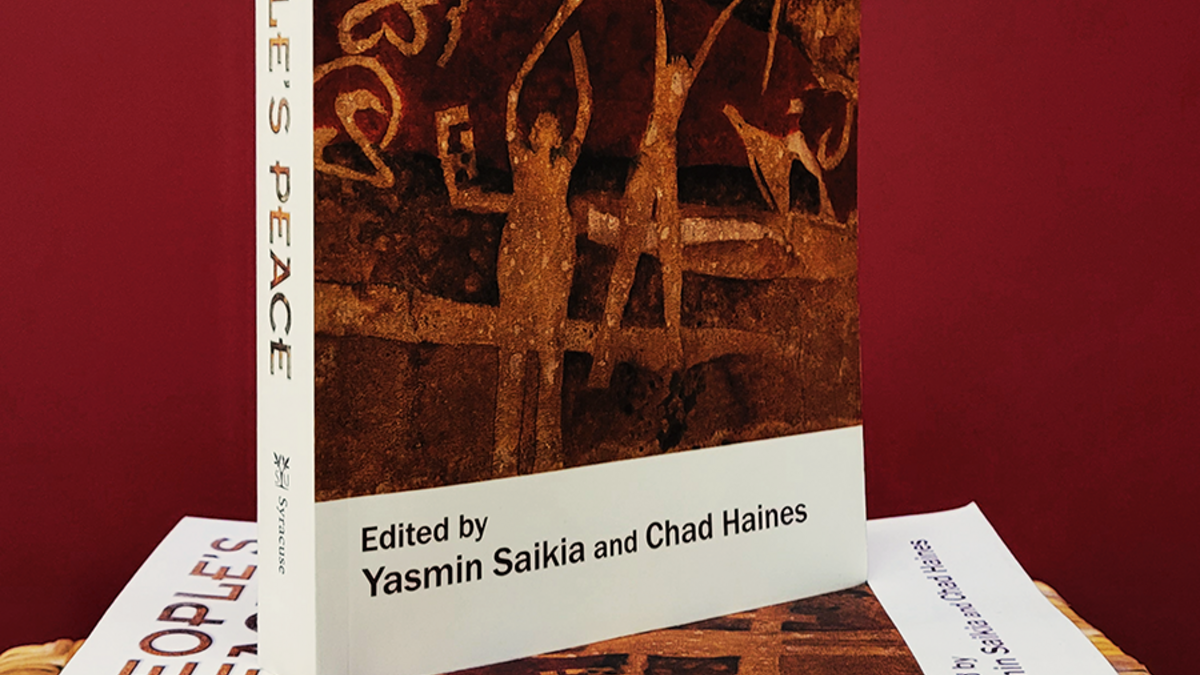Book offers new ways to understand peace

"People's Peace" spans a range of humanities disciplines and offers a unique perspective on people’s daily lives across the world as they struggle to create peace despite escalating political violence.
Throughout Western history, the concept of peace has been associated with the absence or ending of war.
In the book “People’s Peace: Prospects for a Human Future,” editors Yasmin Saikia, the Hardt-Nickachos Chair in Peace Studies at the Center for the Study of Religion and Conflict, and Chad Haines, associate professor of religious studies at Arizona State University, assert that violence and war cannot bring peace. Rather, they contend that relationship building between people of different communities is the essential ingredient for peace.
“For many people in our world today, the promise of peace made by those in power appears romantic and abstract,” Saikia says. “It has acquired the unreality of a dream. Yet we cannot walk away and abandon that dream, even though we understand its dim prospects. Living peacefully is a primary concern of the majority of people.”
Saikia and Haines rest their hopes for peace in ordinary people. In the book, they present 12 essays highlighting local, cultural and social practices of everyday people as they strive to maintain harmony with others and create an environment of peace. Examples range from how ancient Jews established communal justice to exploring how Black and white citizens in Ferguson, Missouri, are working to achieve racial harmony.
The book is divided into two parts. The first seven essays present religious and philosophical interpretations of people’s peace. The final five essays present case studies from diverse times and places. In all, the book covers ancient Israel, 16th century Spain and 19th century United States to contemporary Egypt, Bosnia, India, Pakistan, Philippines, El Salvador, Indonesia, United States and Israel/Palestine.
“The fact is that the majority of people do not participate in the theater of war,” Haines says. “They resist the confrontational approach and continue to respect and dignify those who are different from themselves. The 12 essays in this volume show that people have a common understanding of peace as a right.”
“People’s Peace” attempts to shift the study of peace from official organizations and institutions to people’s lives and lived culture. Each chapter examines an instance — some historical, others contemporary — where individuals defy authority or overcome cultural stigmas to assert the value of peaceful relations with others.
In the book’s conclusion, Saikia and Haines relate the story of Amir, a soldier in the Bosnian army who was badly injured by Serbian snipers. After the war, he suffered financially, emotionally and psychologically; his wife left him and he had to raise three children on a tiny pension. Yet Amir harbored no ill will toward his former enemies, insisting he would welcome a Serbian to his family if one of his children wanted to marry one.
“We learned from Amir the possibility of having a humane response to hatred and transcending one’s own traumas to see in the other a friend, neighbor, and even a family member,” Saikia says. “The acceptance expressed by Amir perfectly encapsulates our understanding of 'people' when it comes to expressions and actions of peace.”
The book “People’s Peace,” published in 2019, grew out of a conference the Center for the Study of Religion and Conflict hosted in 2015. Scholars from Duke, George Mason, Saint Louis and Yale universities, Boston College, the universities of Pittsburgh and Notre Dame, as well as ASU, participated in the conference and contributed to the book.
“The view of people’s peace that we offer in this book in meant as an invitation to find new ways for thinking about peace,” Haines says. “It also is a celebration of everyday people who claim peace to transform their own communities.”
Written by Barby Grant
More Law, journalism and politics
Can elections results be counted quickly yet reliably?
Election results that are released as quickly as the public demands but are reliable enough to earn wide acceptance may not…
Spring break trip to Hawaiʻi provides insight into Indigenous law
A group of Arizona State University law students spent a week in Hawaiʻi for spring break. And while they did take in some of the…

LA journalists and officials gather to connect and salute fire coverage
Recognition of Los Angeles-area media coverage of the region’s January wildfires was the primary message as hundreds gathered at…

